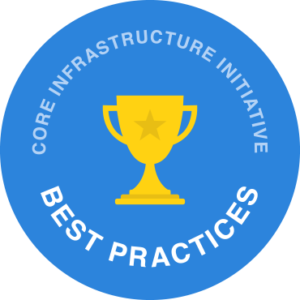You are viewing an old version of this page. View the current version.
Compare with Current
View Page History
« Previous
Version 3
Next »
 The Best Practices Program is an open source secure development maturity model. Projects having a CII badge will showcase the project’s commitment to security. Open source project maintainers answer a short questionnaire to be awarded a “Best Practices Badge”.
The Best Practices Program is an open source secure development maturity model. Projects having a CII badge will showcase the project’s commitment to security. Open source project maintainers answer a short questionnaire to be awarded a “Best Practices Badge”.
In order for an ORAN-SC project to be awarded the basic "passing" grade, a project should score 100% on the following questions. If a question is not applicable, select N/A.
Basics
Basics (12 Points)
(Result/Proof point (column A: enter Met/Unmet; Column B: enter relevant URLs/comments)
| Project A |
| Criteria | Result / Proof point |
|---|
| Identification |
What is the human-readable name of the project? |
|
|
What is a brief description of the project? |
|
|
What is the URL for the project (as a whole)? |
|
|
What is the URL for the version control repository (it may be the same as the project URL)? |
|
|
What programming language(s) are used to implement the project? |
|
|
What is the Common Platform Enumeration (CPE) name for the project (if it has one)? |
|
|
Basic project website content |
| The project website MUST succinctly describe what the software does (what problem does it solve? |
|
|
| The project website MUST provide information on how to: obtain, provide feedback (as bug reports or enhancements), and contribute to the software. |
|
|
| The information on how to contribute MUST explain the contribution process (e.g., are pull requests used?) (URL required) |
|
|
| The information on how to contribute SHOULD include the requirements for acceptable contributions (e.g., a reference to any required coding standard). (URL required) |
|
|
FLOSS license |
| What license(s) is the project released under? |
|
|
| The software produced by the project MUST be released as FLOSS. |
|
|
| It is SUGGESTED that any required license(s) for the software produced by the project be approved by the Open Source Initiative (OSI). |
|
|
| The project MUST post the license(s) of its results in a standard location in their source repository. |
|
|
| Documentation |
| The project MUST provide basic documentation for the software produced by the project. |
|
|
| The project MUST provide reference documentation that describes the external interface (both input and output) of the software produced by the project. |
|
|
| Other |
| The project sites (website, repository, and download URLs) MUST support HTTPS using TLS. |
|
|
| The project MUST have one or more mechanisms for discussion (including proposed changes and issues) that are searchable, allow messages and topics to be addressed by URL, enable new people to participate in some of the discussions, and do not require client-side installation of proprietary software. |
|
|
| The project SHOULD provide documentation in English and be able to accept bug reports and comments about code in English. |
|
|
Change Control
Change Control (9 Points)
(Result/Proof point (column A: enter Met/Unmet; Column B: enter relevant URLs/comments)
| Project A |
| Criteria | Result / Proof point |
|---|
Public version-controlled source repository |
The project MUST have a version-controlled source repository that is publicly readable and has a URL. |
|
|
The project's source repository MUST track what changes were made, who made the changes, and when the changes were made. |
|
|
To enable collaborative review, the project's source repository MUST include interim versions for review between releases; it MUST NOT include only final releases. |
|
|
It is SUGGESTED that common distributed version control software be used (e.g., git) for the project's source repository. |
|
|
Unique version numbering |
|
|
The project results MUST have a unique version identifier for each release intended to be used by users |
|
|
It is SUGGESTED that the Semantic Versioning (SemVer) format be used for releases. |
|
|
It is SUGGESTED that projects identify each release within their version control system. For example, it is SUGGESTED that those using git identify each release using git tags. |
|
|
Release notes |
The project MUST provide, in each release, release notes that are a human-readable summary of major changes in that release to help users determine if they should upgrade and what the upgrade impact will be. The release notes MUST NOT be the raw output of a version control log (e.g., the "git log" command results are not release notes). Projects whose results are not intended for reuse in multiple locations (such as the software for a single website or service) AND employ continuous delivery MAY select "N/A". (URL required) |
|
|
The release notes MUST identify every publicly known vulnerability with a CVE assignment or similar that is fixed in each new release, unless users typically cannot practically update the software themselves. If there are no release notes or there have been no publicly known vulnerabilities, choose "not applicable" (N/A). |
|
|
Reporting
Quality
Security
Analysis
